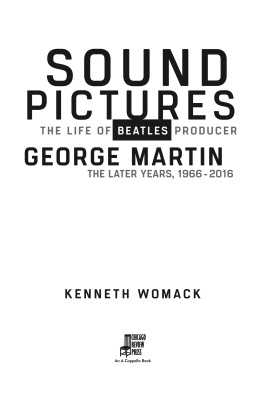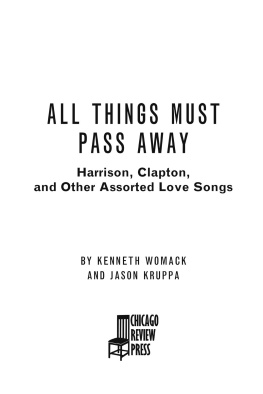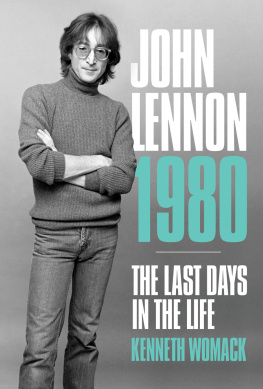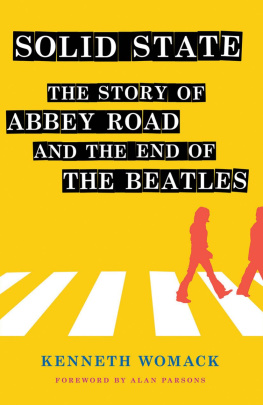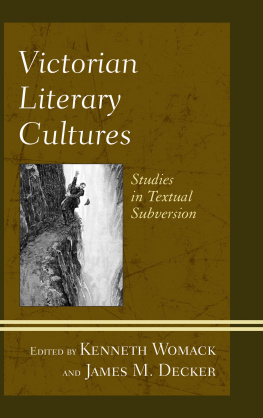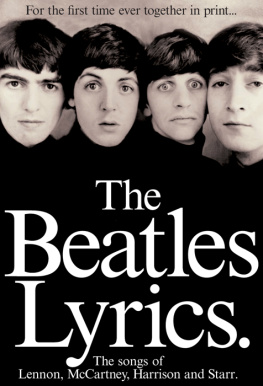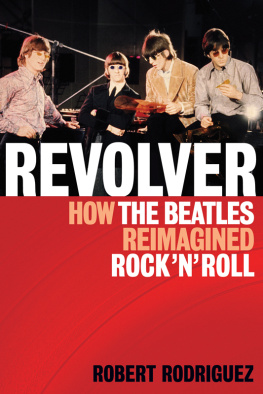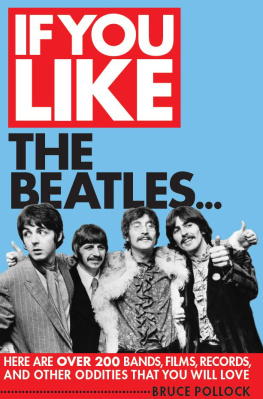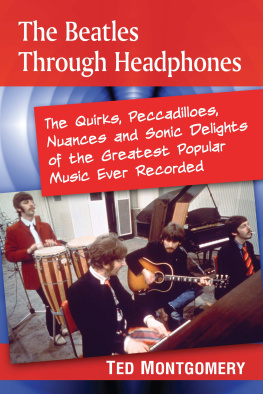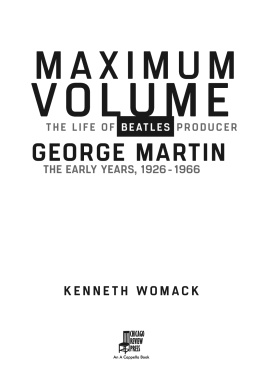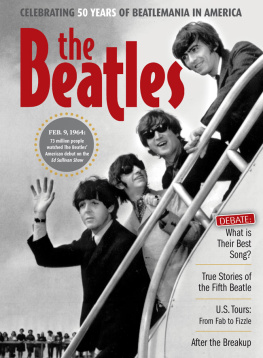Sommaire
Pagination de l'dition papier
Guide
Copyright 2018 by Kenneth Womack
All rights reserved
First edition
Published by Chicago Review Press Incorporated
814 North Franklin Street
Chicago, Illinois 60610
ISBN 978-0-912777-77-1
Library of Congress Cataloging-in-Publication Data
Names: Womack, Kenneth, author.
Title: Sound pictures: the life of Beatles producer George Martin: the late
years, 1966-2016 / by Kenneth Womack.
Description: First edition. | Chicago, Illinois: Chicago Review Press, [2018
| Includes bibliographical references.
Identifiers: LCCN 2018009547 (print) | LCCN 2018011496 (ebook) | ISBN 9780912777757 (adobe pdf) | ISBN 9780912777764 (kindle) | ISBN 9780912777771 (epub) | ISBN 9780912777740 (cloth)
Subjects: LCSH: Martin, George, 1926-2016. | Sound recording executives an
producersEnglandBiography. | Beatles. | LCGFT: Biographies.
Classification: LCC ML429.M34 (ebook) | LCC ML429.M34 W67 2018 (print)
| DDC 781.66/149092 [B] dc23
LC record available at https://lccn.loc.gov/2018009547
Typesetting: Nord Compo
Printed in the United States of America
5 4 3 2 1
This digital document has been produced by Nord Compo.
For Becca and PMo:
All You Need Is Love!
We should always remember that sensitiveness and emotion
constitute the real content of a work of art.
Maurice Ravel
Prologue
Get Back to Where
You Once Belonged
F OR GEORGE MARTIN, it came in the form of a most unexpected telephone call. And from no less than Paul McCartney.
It was a late spring day in 1969, and Englands most esteemed record producer was sitting in his office on Londons Park Street, toiling away at AIR (Associated Independent Recording), the company he founded four years earlier after experiencing one rebuff too many at the hands of the vaunted EMI Group.
And what a rebuff it had been. After leading EMIs Parlophone Records label with a steady hand for more than a decade, the normally staid George simply couldnt take it anymore. Within the space of a scant eighteen monthsfrom the autumn of 1962 through the spring of 1964he had transformed Parlophone from a modest comedy imprint into EMIs most valuable, blue-chip musical property. His production had earned EMI a kings ransom many times overtens of millions of pounds, quite literallyand what did he have to show for it? In 1963, his salary amounted to a paltry 3,000 during a year in which the records he produced held the number-one position on the British charts for a phenomenal thirty-seven weeks.
But by the spring of 1969, the high tide of Beatlemania was just a memory. As the days and weeks passed since he had last seen the bandmates, the man whom the Beatles lovingly referred to as Big George had begun to assume that he would never work with the group again. Indeed, it was the longest hed gone without seeing them since their February 1968 sojourn to Rishikesh in the company of the Maharishi Mahesh Yogi. Only this time, it was different. This time it had seemed eminently more final.
On the one hand, George was relieved by the respite, having grown tired of the emotional roller coaster. The heartbreak had simply become too much to bear. Yet on the other hand, he was terribly sad to see them go out with a whimper after such masterworks as Rubber Soul, Revolver, and Sgt. Peppers Lonely Hearts Club Band. Surely, their last gasp wouldnt be in the form of the failed Get Back LP, with all of the attendant infighting and the would-be albums crude and haphazard production efforts?
What a shame to end like this, George thought to himself at the time. But then, to his great surprise, Paul had phoned him out of the blue. So unexpected, yet at the same time, so very welcome to Georges ears. Paul wasted little time in getting down to business: Were going to make another record, he announced. Would you like to produce it? For his part, Georges reply was immediate and firm. Only if you let me produce it the way we used to, he answered. We do want to do that, said Paul. John included? asked George, overbrimming with caution. Yes, Paul replied. And then, as an afterthought: Honestly.
For all of his understandable hesitation in that call, George was undeniably intrigued. Only a short time later, he was back in the familiar environs of Studio 2, assisting Paul in nailing down a lead vocal in the service of a new and as of yet untitled Beatles album. But as Pauls fellow band members assembled in the studio in the coming days for one more stab at greatness, George worried, justifiably, whether or not they could recapture the magic of days gone by.
Was it even possible, at this late date, to take the Beatles sad song and make it better?
You Say
Its Your Birthday!
O N JANUARY 3, 1966, George Martin celebrated his fortieth birthday with his fiance Judy Lockhart Smith by his side. With marriage in the offing, Georges future shone brightly. On the professional front, he had just completed production work on Rubber Soul, the Beatles latest studio album and their sixth straight UK chart-topper. The long-player had proven to be pioneering in every sense of the word. As George later observed, I think Rubber Soul was the first of the albums that presented a new Beatles to the world. Up to this point, we had been making albums that were rather like a collection of their singles and now we really were beginning to think about albums as a bit of art in their own right. We were thinking about the album as an entity of its own, and Rubber Soul was the first one to emerge in this way. Like Paul McCartney, George perceived the album as a result of a growing collaboration between himself and the Beatles, as opposed to the more authoritative position that he had assumed with earlier projects. Previously, George had a lot of controlwe used to record the stuff, and leave him to mix it, pick a single, everything, Paul later remarked. After a while though, we got so into recording wed stay behind while he mixed it, watching what he was doing. But for his part, John Lennon had already begun to see the bandmates working relationship with George evolving even further still. We were getting better technically and musically, thats all. We finally took over the studio, John observed. With Rubber Soul, we were more precise about making the albumthats all. We took over the cover and everything.
Forced to produce the long-player between the Beatles stints on the road, George had delivered Rubber Soul in breakneck fashion. Recorded between October 12 and November 15, 1965, the album was mastered for release and in the shops by December 3, along with the bands latest single, Day Tripper backed with We Can Work It Out. In the space of slightly more than fifty days, George and the Beatles had brought sixteen new tracks to fruition and into the hands of Beatles fans across the globe. Such was the pace in those heady days of midperiod Beatlemania. As it happened, there was no rest for the bandmates, who performed eighteen concerts that same month on their UK winter tour. Not surprisingly, by the time the new year rolled around, the Beatles were drained. But the same could hardly be said for their producer, who had just concluded another banner year in which his acts had reigned atop the charts, and who also ended his long-standing employment with the EMI Group to establish a consortium of producers known as Associated Independent Recordingor AIR for short. But rather than giving in to exhaustion, George had been buoyed by the exhilarating experience of going into business for himself. As George later observed, My workload was enormous so that I was spending more time in the studio than I was anywhere else. And I found myself completely and utterly wrapped up in my work.

